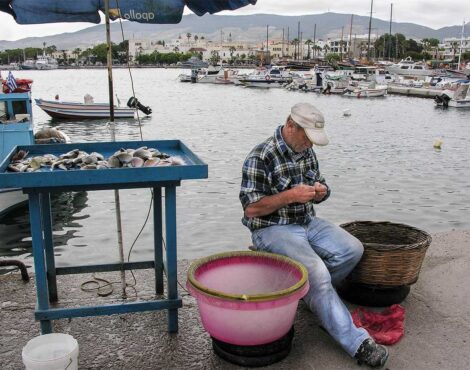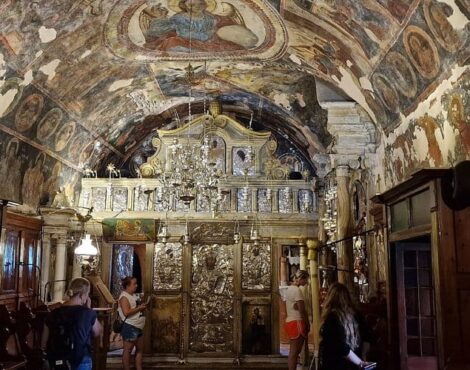Introduction: Echoes in the Hills
Corfu is often celebrated for its lively Old Town, its golden beaches, and its cosmopolitan flair. Yet hidden away in the folds of its hills and valleys lie silent witnesses of another era: the forgotten villages. These abandoned or nearly deserted settlements tell stories of resilience, hardship, and migration. Walking through their crumbling stone houses, empty squares, and overgrown paths is like stepping back in time — a reminder that behind the island’s vibrant present lies a quieter, sometimes melancholic, but deeply fascinating past.
Why Villages Were Abandoned
The reasons why many of Corfu’s villages were left behind vary, but they often include:
- Rural Decline: As younger generations moved to Corfu Town or emigrated abroad in search of work, entire communities dwindled.
- Isolation: Harsh winters, limited access to water, or challenging terrain made daily life unsustainable.
- Pirate Threats (in earlier centuries): Many inland villages were originally built to escape pirate raids, but later, when danger subsided, populations shifted back to the coast.
Today, these villages stand as cultural relics, offering visitors not just photogenic ruins but also powerful narratives of human endurance and change.
1. Old Perithia – The Timeless Ghost Village
Perhaps the most famous of Corfu’s forgotten villages, Old Perithia lies on the northern slopes of Mount Pantokrator. Founded in the 14th century, it was once a thriving settlement with over 100 houses and multiple churches. Its location inland protected it from pirates, and its fertile soil sustained generations.
By the mid-20th century, however, residents had relocated to the coast, leaving Old Perithia to crumble. In recent years, some homes have been carefully restored, and a handful of tavernas welcome visitors.
Highlights:
- Venetian-style stone houses with arched doorways.
- Eight surviving churches, each with unique frescoes.
- A sense of “living history,” where silence and nature reclaim the streets.
2. Sinies – Forgotten on the Slopes
Nestled on the lower slopes of Pantokrator, the village of Sinies was once an important hub for olive oil production. Today, its stone walls are covered in ivy, and the pathways are quiet except for the sound of cicadas. The remains of olive presses still stand, silent reminders of the community’s livelihood.
Why Visit:
- Experience authentic rural abandonment.
- Combine with a hike up Pantokrator.
- Photographers will love the atmospheric ruins.
3. Kato Korakiana’s Hidden Corners
While Ano and Kato Korakiana are still inhabited, parts of these villages bear the scars of abandonment. Wandering through their backstreets, you’ll find shuttered houses, broken balconies, and overgrown gardens. Yet at the same time, locals keep certain squares alive, creating a fascinating mix of old and new.
Tip: Visit during evening hours when the light falls golden on the abandoned facades, creating dramatic contrasts with the lived-in parts of the village.
4. Paleochori – The Vanished Settlement
Near Agios Mattheos, Paleochori is almost completely abandoned. A handful of stone houses lie hidden in the olive groves, their roofs collapsed and windows empty. Walking here feels like stumbling across a lost world, especially in spring when wildflowers bloom through the cracks.
Best For: Adventurers seeking off-the-beaten-path exploration.
5. Porta – Gateway to the Past
High in the hills above Pelekas, the village of Porta once bustled with life but is now mostly deserted. Its name means “gate,” and fittingly, it feels like a threshold between past and present. Some houses are inhabited seasonally, while others stand in ruins, echoing with memories of families long gone.
Why Visit:
- Stunning views over western Corfu.
- A chance to witness the resilience of structures built centuries ago.
Life in Forgotten Villages
Despite their abandonment, these villages are not just relics of the past. They often come alive on feast days and festivals, when descendants return to celebrate their heritage. Temporary gatherings bring music, food, and joy into spaces that otherwise remain silent.
Cultural Insight:
- Traditional dishes like pastitsada and sofrito are often cooked in village squares.
- Folk music fills the air, reviving traditions that have endured despite migration.
Nature Reclaims the Ruins
One of the most striking aspects of these forgotten places is how nature has embraced them. Ivy climbs stone walls, wildflowers sprout from cracked roofs, and lizards dart through doorways where families once lived. The interplay between human creation and natural reclamation makes these sites hauntingly beautiful.
Photography Tip: Early morning mist or late afternoon light enhances the atmosphere.
Practical Tips for Exploring
- Wear sturdy shoes: Paths can be uneven or slippery.
- Bring water: Many villages are remote, with no amenities.
- Respect the ruins: Some houses are fragile; avoid climbing on unstable structures.
- Ask locals: They often know the hidden paths and can share personal stories.
Why Forgotten Villages Matter
Exploring abandoned villages is not only about curiosity — it’s about connecting with Corfu’s deeper history. These places remind us of the cycles of prosperity and decline, of resilience and adaptation. They offer a counterpoint to the island’s bustling resorts, allowing us to reflect on what it means to belong, to leave, and to return.
Conclusion: Walking Through Time
To wander through Corfu’s forgotten villages is to walk through layers of history. Each crumbling wall whispers of laughter once shared, of struggles endured, of traditions carried forward even in absence. Whether you explore Old Perithia’s ghostly beauty or stumble upon a hidden chapel in Paleochori, these experiences offer something profound: a chance to see the island not just as it is, but as it once was.
For travelers seeking authenticity, mystery, and a deeper connection with place, Corfu’s forgotten villages are not empty — they are full of stories, waiting for you to listen.





